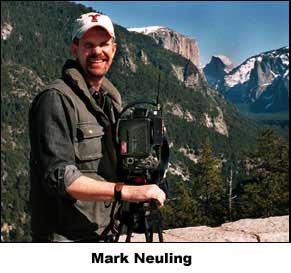WITHOUT
PICTURES...IT'S ONLY RADIO
By Mark Neuling
Photojournalist
| Football
season is upon us again. I’m
talking about the kind of football that’s played
on Friday nights. In
some places there might only be a few dozen folks in the
stands, at others there could be several thousand. In
small towns and large towns all across America; Friday’s
are for high school football. |

A high school football player turns up field at Woodside
High School, Woodside, California. November 15, 1997.
©Mark
Neuling 2004 |
|
Early in my television career I worked out of a small production
truck doing multiple-camera cablecasts of high school games. We
had one real-time instant replay machine; the announcers weren’t
very good; they were volunteers. It was primitive but it was
also a great learning experience as I was working along side professionals
who had worked a variety of sporting events including the Olympics.
In time I moved on to a “broadcast” station where for a
decade I spent Friday’s traveling throughout the San Francisco
Bay Area taping highlights that we would air later that evening. Some
of these schools I’ve been to dozens of times; other schools
I've passed through only once. There are schools I’ve taught
or coached at. Some of the fields I played football on as a teenager. I
know that from Washington High School in San Francisco I can see the
spires of the Golden Gate Bridge. From the stands of Half Moon
Bay High School I can see the sun set into the Pacific. And of
course I learned which schools had the best barbecued hot dogs for
those quick half time dinners.
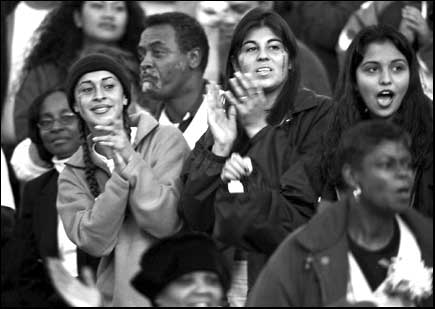
Fans cheer for their team. Woodside, California. November
15, 1997.
©Mark Neuling 2004 |
|
The Bay Area is a microcosm of peoples, races and cultures. But high school
football is one of the unifying forces that can touch nearly everyone. Black
and white, Hispanic or Asian, rich and poor; from urban schools to rural ones,
public or private, most schools field a football team. While the Bay Area
may not be as rabid about football as say Texas, we hold our own here. De
La Salle High School in Concord took on all comers and set a national record
in winning 151 straight games dating back to 1991. |
High
school football hasn’t changed a great deal in the decades
since I played it. Yes there are artificial surfaces now,
but the lighting at most fields is still lousy. The kids
seem to spend more time hitting the weights and the defenses are
more sophisticated;
but there are still skinny 6’3” 175 pound kids trying
to tackle two hundred pound tailbacks who’ll be getting scholarships
to college because they can run a hundred yards in less than
ten seconds and hit you like a load of bricks.
One
thing that has changed is the amount of television coverage
that high school sport in general gets. In my day, simply
put, there was no television reporting for prep sports of any
kind. Only the local paper covered us with any kind of
consistency. But back in the early 90’s the little
independent station I worked for decided to take a bold step. They
started a half-hour show on Friday nights devoted entirely
to high school football.
| Over
the years the show grew to an hour, spanned 40 weeks, covered
a geographic area from Marin to Monterey and expanded it’s
coverage to include basketball, volleyball, soccer, softball
and baseball while giving exposure to lesser sports as
well. Athletes I’ve covered and done stories
on have gone on to the professional ranks, Olympic gold
and the cover of Sports Illustrated. |

Cameraman
Ric Shiraki shoots post-game congratulations at a championship
basketball game. January – 1995.
©Mark Neuling 2004 |
|
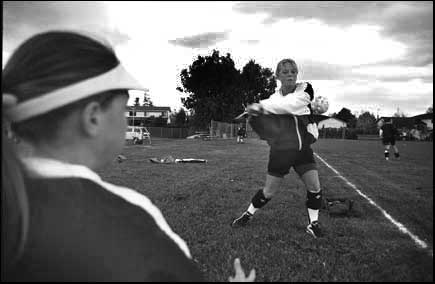
Softball
practice starts in the Silicon Valley. Spring – 1998.
©Mark Neuling 2004 |
|
Ours
was the station in the Bay Area that was associated with
prep sports. When, on the rare occasion that other
stations were at a game, they were often mistaken for our
crews. Their highlights could rarely hold a candle
to ours. Because
of our experience and the frequency with which we covered the
prep sport beat, our staff became highly proficient at shooting
sports; and the shooters were all highly competitive with each
other. We
wanted our stuff to be as good as NFL Films even if it was only
high school ball. |
| Usually
the schedule was two games on Friday afternoon. Shoot
the first half of one game, the second half at the other
and pray we got two or three touchdowns from each contest. Then
drive back to San Jose. We’d drop the tapes
off with a log and roster and turn around to do it all
over again at a pair of evening games, fighting rush hour
traffic the whole way. |
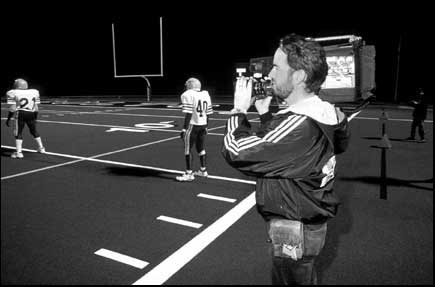
Cameraman and good friend Paul Felt prepares to shoot
a kick off at Logan High School, Union City, California.
November 1996.
©Mark Neuling 2004 |
|
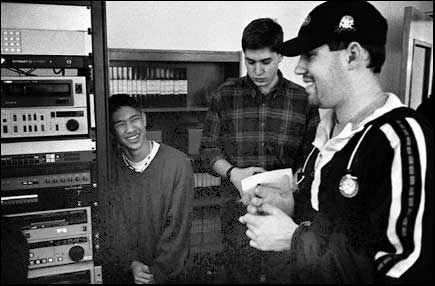
Intern Brian Tong, reporter J.D, Preuss and cameraman
Mark Willis relax in the edit bay after a show. January
1999.
©Mark Neuling 2004 |
|
The
goal was to be back at the station by 10 p.m., cut our
highlights, work out a rough script with an intern and
finally hand it off to a producer for the final goal line
plunge. Some how we managed to get final scores for games
we’d left at halftime. The show went live at
11 p.m. It got real crazed at times. |
Friday’s
were long days, the over time was good but the camaraderie
was better. Most importantly the impact we made on
the community was measurable.
But I left all that behind several years and a couple of jobs
ago. Recently
I got a call from the chief photographer of that same little station. They
were gearing up to do another season of high school football. Their
long-standing producer had left for a job with a network affiliate
and things were in a bit of disarray. The chief photographer
wanted to know, since I have time to freelance now, if I’d be
interested in coming back to shoot for them. But he was embarrassed
to ask me. Station management was drawing the line
at twelve dollars an hour for shooters.
I want to pose a question to the news directors, sports directors
and station managers who set these rates; have you ever
really thought what your photographers are worth and how valuable
the pictures are
that they produce? These are the people who go into the field,
representing your station, with any where from twenty thousand to perhaps
a hundred thousand dollars worth of gear. Most of
these men and women have four years of college, some have years of
experience. Aren’t the pictures, sounds, stories
and commercials they put on your air worth more than twelve dollars
an hour. And who is it that the public comes into contact with
the most? Usually it’s your photographers.
Sadly twelve dollars an hour works out to around twenty five
thousand dollars a year. It’s been several years since I last saw
an industry average for television photographers, but I’d
guess that twelve dollars an hour is around the salary
norm now.
As for me, yes I’ve worked for a lot less than twelve dollars
an hour, but that was when Ronald Reagan was president. I know
that many young photographers working for small stations are glad to
get any kind of living wage and the experience that goes along with
it. And they do it in order to move on to bigger stations in
larger markets where the pay and conditions are better. Sure
you’re doing this for your “resume tape;” and I’m
all for paying your dues. But I paid my dues a long time ago. I
no longer get any special thrill from being allowed into any kind of
sporting event for free any more.
Lugging
a BETACAM up and down the sidelines in front of a crowd
is no longer cool; it’s hard work. Getting
sound after a game, meeting deadlines, editing tape,
writing scripts and making dozens of different decisions
every night ought to be worth more than twelve bucks
an hour.
I admit that I miss shooting sports, particularly football. But I
couldn’t get every Friday off anyway with my current work schedule. Besides
I don’t really need all the headaches that come with the job, especially
the twelve dollar an hour kind. I’m in a position where I can say
no to some work. At least I can for this year; as for next football
season, well you never know.
|

A Mills High School player after a hard hit at Woodside
High School, Woodside, California. November 15, 1997.
© Mark Neuling 2004 |
|
© Mark Neuling 2004
The opinions expressed are still, solely those of the author.
© Mark Neuling 2004
Email address is now – theneulings@Juno.com
|

